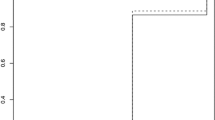Abstract
We report a surprising property of μ-σ-preferences: the assumption of nonincreasing relative risk aversion implies the optimal portfolio being riskless. We discuss a solution of that paradox using wealth dependent utility functions in detail. Using the revealed preference theory we show that (general, i.e. not necessary μ-σ) wealth dependent utility functions can be characterized by Wald's axiom.
Similar content being viewed by others
References
Allingham, M. (1991). “Existence Theorems in the Capital Asset Pricing Model,” Econometrica 59, 1169–1174.
Bakshi, G. and Z. Chen. (1996). “The Spirit of Capitalism and Stock-Market Prices,” American Economic Review 86, 133–157.
Crouzeix, J.-P. (1981). “Continuity and Differentiability Properties of Quasiconvex Funktions on r n.” In S. Schaible and W. Ziemba (eds.), Generalized Concavity in Optimization and Economics. New York: Academic Press, pp. 109–130.
Dalal, A. and B. Arshanapalli. (1993). “Estimating the Demand for Risky Assets via the Indirect Expected Utility Function,” Journal of Risk and Uncertainty 6, 277–288.
Duffie, D. (1988). Security Markets. San Diego: Academic Press, Inc.
Hildenbrand, W. (1994). Market Demand: Theory and Empirical Evidence. Princeton, NJ: Princeton University Press.
Ingersoll, J. (1987). Theory of Financial Decision Making. Totowa, NJ: Rowmanand Littlefield.
John, R. (1995). “The Weak Axiom of Revealed Preference and Homogeneity of Demand Functions,” Economics Letters 47, 11–16.
Lajeri, F. and L. Nielsen. (1994). “Risk Aversion and Prudence: The Case of Mean-Variance Preferences,” INSEAD.
Levy, H. (1994). “Absolute and Relative Risk Aversion: An Experimental Study,” Journal of Risk and Uncertainty 8, 289–307.
Levy, H. and H. Markowitz. (1979). “Approximating Expected Utility by a Function of Mean and Variance,” American Economic Review 69(3), 308–317.
Loffler, A. (1996). “Variance Aversion Implies μ-σ 2 Criterion,” Journal of Economic Theory 69, 532–539.
Magill, M. and M. Quinzii. (1996). Theory of Incomplete Markets. Cambridge, MA: MIT Press.
Markowitz, H. (1952a). “Portfolio Selection,” Journal of Finance 7, 77–91.
Markowitz, H. (1952b). “Utility of Wealth,” Journal of Political Economy 60, 151–158.
Meyer, J. (1987). “Two-Moment DecisioModels and Expected Utility Maximization,” American Economic Review 77, 421–430.
Nielsen, L. (1990). “Existence of Equilibrium in CAPM,” Journal of Economic Theory 52, 223–231.
Orth, H. (1994). “Ein Experiment zum Gesetz der Marktnachfrage,” Diplomarbeit, Universitat Bonn, Wirtschaftswissenschaftliche Fakultat. ¨
Samuelson, P. (1970). “Maximum Principles iAnalytical Economics,” Les Prix Nobel e1970, The Nobel Foundation. Reprinted in Robert C. Mertoed., The Collected Scientific Papers of Paul A. Samuelson. Cambridge, MA: MIT Press, 1972, chapter 130.
Sharpe, W. (1964). “Capital Asset Prices: A Theory of Market Equilibrium under Conditions of Risk,” Journal of Finance 19, 425–442.
Sinn, H.-W. (1983). Economic Decisions under Uncertainty. Amsterdam, New York and Oxford: North-Holland Publishing Company.
Sippel, R. (1994). “An Experiment on the Pure Theory of Consumer's Behavior.” Discussion Paper B-274, Universitat Bonn, SFB, 303.
Sippel, R. (1997). “An Experiment on the Pure Theory of Consumer's Behavior,” The Economic Journal 107, 1431–1444.
Tobin, J. (1958). “Liquidity Preference as Behavior Towards Risk,” Review of Economic Studies 25, 65–86.
Author information
Authors and Affiliations
Rights and permissions
About this article
Cite this article
Löffler, A. A μ-σ-Risk Aversion Paradox and Wealth Dependent Utility. Journal of Risk and Uncertainty 23, 57–73 (2001). https://doi.org/10.1023/A:1011164615592
Issue Date:
DOI: https://doi.org/10.1023/A:1011164615592




